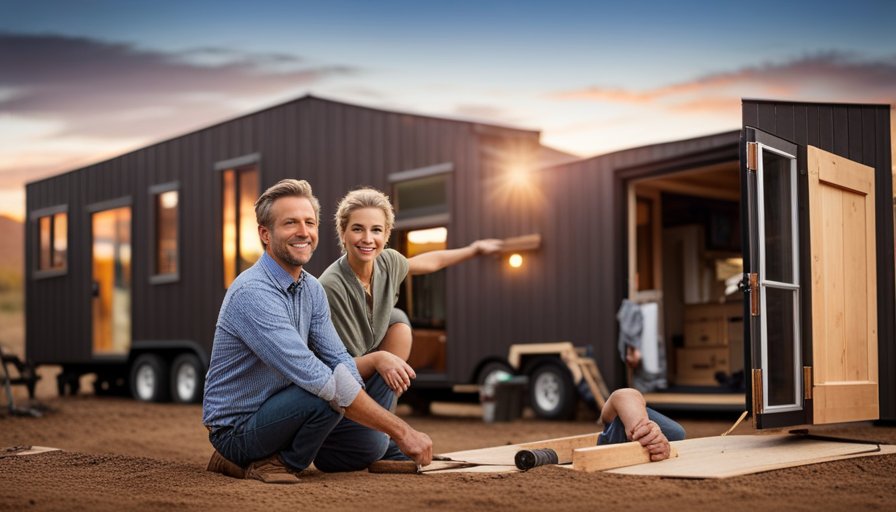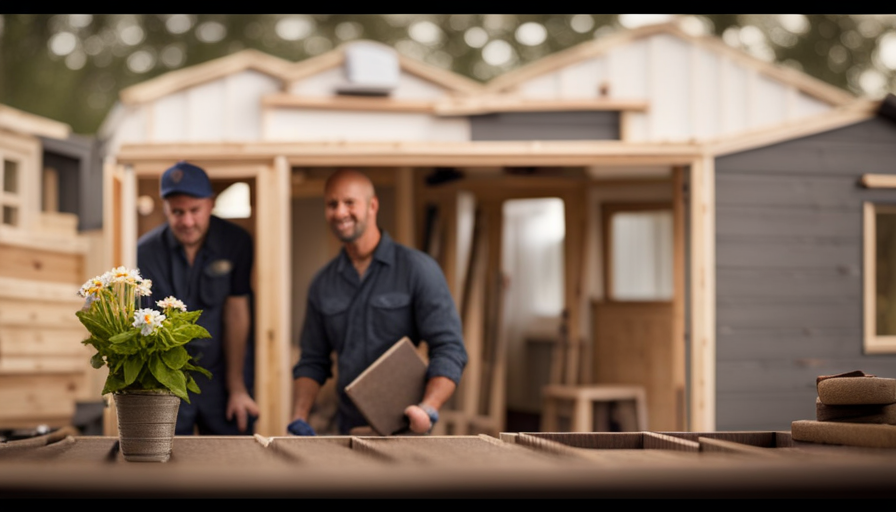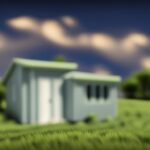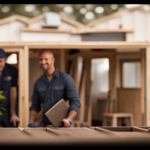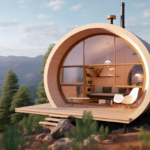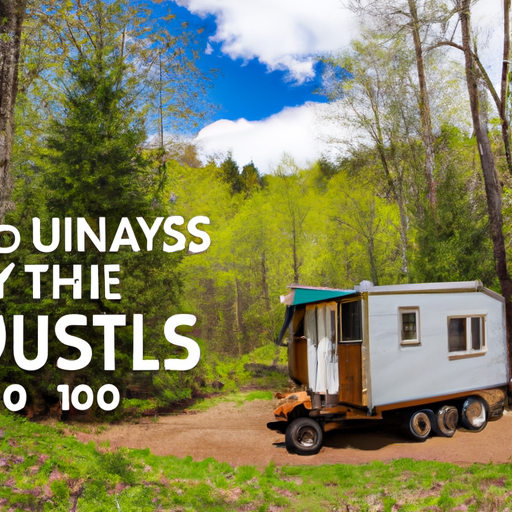Have you ever dreamt of owning a home but thought it was too expensive? I’m here to tell you that building a tiny house could be a wallet-friendly alternative. Yes, you heard me right – a tiny house! These cozy and compact homes have become increasingly popular recently, offering a simpler and eco-friendly way of living. Discover the benefits of tiny house living and why it might be the perfect choice for you.
But how can you build one cheaply? In this article, I will guide you through the process of constructing a tiny house on a budget. From setting a realistic financial plan to sourcing affordable materials and incorporating energy-efficient features, I will share valuable tips and tricks to help you save money while creating your dream home.
So, if you’re ready to embrace minimalism and simplify your lifestyle, let’s get started on your journey to building a tiny house cheaply.
Key Takeaways
- Setting a realistic budget is important
- Research affordable building techniques
- Source affordable and sustainable materials
- Embrace minimalism and simplify lifestyle for affordability and sustainability
Set a Budget and Stick to It
You should establish a budget and ensure you adhere to it diligently in order to construct a tiny house cost-effectively. Stick to your budget, but don’t compromise on quality. It’s important to have a clear understanding of how much you can afford to spend on your tiny house project. This will help you make informed decisions throughout the construction process and avoid overspending.
Research affordable building techniques to find ways to save money without sacrificing the quality of your tiny house. There are many resources available online and in books that provide tips and tricks for building a tiny house on a budget. By taking the time to educate yourself on these techniques, you can make smart choices and potentially save thousands of dollars.
Now that you have set your budget, let’s move on to the next step: choosing a suitable location for your tiny house. This decision will have a significant impact on your overall cost and the enjoyment you get from living in your tiny house.
Choose a Suitable Location for Your Tiny House
Looking for an affordable spot to place your cozy abode? Choosing the right location for your tiny house is a crucial step in building it cheaply.
There are several factors to consider when deciding on the perfect spot.
First, you need to decide whether you want to live in an urban or rural area. Urban areas may provide more convenience and access to amenities, but they often come with higher land prices. On the other hand, rural areas are usually more affordable, but you may have to sacrifice some conveniences.
Next, consider whether you want to rent or buy the land for your tiny house. Renting can be a more cost-effective option in the short term, but buying land can provide long-term stability and potential for investment.
It is also important to research local zoning regulations before settling on a location. Some areas have restrictions on where you can park or build a tiny house, so make sure to choose a location that is compliant with the regulations.
Additionally, you may want to explore off-grid options for your tiny house. This can include using solar power, rainwater collection, and composting toilets to reduce your reliance on utilities and lower your expenses.
Lastly, consider the benefits of community living. Living in a tiny house community can provide a sense of camaraderie, shared resources, and lower costs.
Once you have chosen a suitable location, the next step is to design a functional and efficient floor plan.
Design a Functional and Efficient Floor Plan
Consider creating a space-efficient and well-organized layout for your compact dwelling. When designing the floor plan for your tiny house, it’s crucial to prioritize efficient space utilization and incorporate creative storage solutions.
Every square inch counts in a small living space, so it’s essential to make the most of it. Start by identifying your needs and priorities. Think about how you’ll use each area of the house and what activities will take place there. This’ll help you determine the best layout for your specific lifestyle. Consider multifunctional furniture, such as a sofa that can turn into a bed or a dining table that can double as a workspace.
Maximize vertical space by utilizing tall cabinets and shelving units. You can also incorporate hidden storage compartments beneath stairs or built-in wall units. Think creatively about every nook and cranny, and explore options like wall-mounted storage solutions or hanging organizers.
Additionally, consider an open floor plan that allows for flexibility and a sense of spaciousness. By eliminating unnecessary walls, you can create a more fluid and open living area.
Source Affordable and Sustainable Building Materials
To create a cost-effective and eco-friendly tiny home, it’s important to find affordable and sustainable building materials. When sourcing materials, I recommend looking for options that are both affordable and environmentally friendly.
One great way to find affordable building materials is to check out local salvage yards, where you can often find reclaimed materials at discounted prices. These salvaged items can add a unique touch to your tiny home while also reducing your carbon footprint.
Another option for affordable and sustainable construction is to use recycled or repurposed materials. For example, you can use reclaimed wood for flooring, walls, and even furniture. This not only saves money but also gives your tiny home a rustic and cozy feel.
When it comes to sustainable construction options, consider using materials that are renewable, such as bamboo or cork. These materials are not only affordable but also have a lower environmental impact compared to traditional building materials like concrete or steel.
Incorporating energy-efficient materials, such as insulation made from recycled materials or low-flow plumbing fixtures, can also help you save on long-term costs.
By sourcing affordable and sustainable building materials, you can significantly reduce the overall cost of your tiny home while also minimizing your impact on the environment. Consider DIY construction or collaborate with others to further cut down on expenses and create a unique and affordable tiny home.
Consider DIY Construction or Collaborate with Others
If you want to save money and add a personal touch to your eco-friendly home, why not try your hand at DIY construction or team up with others to create something truly unique and affordable?
DIY construction is a great way to save on labor costs and allows you to have full control over the design and building process. There are plenty of resources available online that provide step-by-step instructions and tips for building your own tiny house. From framing to electrical work, you can learn it all and save a significant amount of money in the process.
Collaborative building projects are another option to consider. By pooling resources and skills with friends or family members, you can tackle the construction of your tiny house together. This not only brings down the overall cost but also adds a sense of community and shared accomplishment.
When embarking on a DIY or collaborative building project, it’s important to plan ahead and set realistic goals. Take the time to research and gather the necessary tools and materials before starting. Additionally, don’t be afraid to ask for help or seek advice from experienced builders or tiny house enthusiasts.
Now, let’s explore how you can optimize space and storage solutions in your tiny house.
Optimize Space and Storage Solutions
Maximizing the space in your cozy sanctuary will not only create a sense of organization and efficiency but also ignite a feeling of tranquility and harmony within. When building a tiny house, it’s crucial to optimize the storage capacity to ensure every inch is put to good use.
Creative space-saving ideas are key to achieving this goal. One effective way to maximize storage capacity is by utilizing vertical space. Install shelves or cabinets that reach up to the ceiling, providing ample room for books, clothes, and other belongings. Additionally, consider incorporating multipurpose furniture, such as a sofa with built-in storage or a bed with drawers underneath. These clever solutions will help you make the most of limited space.
Another strategy is to utilize hidden storage compartments. Build storage units beneath staircases or create secret compartments within walls or furniture. These hidden spaces are perfect for storing items that aren’t frequently used, keeping your tiny house clutter-free.
Furthermore, consider using wall-mounted organizers, hooks, and magnetic strips to keep smaller items like keys, utensils, and tools within easy reach. These simple additions can greatly enhance the efficiency of your tiny house.
By maximizing storage capacity and implementing creative space-saving ideas, you can create a functional and organized living space in your tiny house.
Next, we’ll explore how to utilize recycled and repurposed materials to further reduce costs and environmental impact.
Utilize Recycled and Repurposed Materials
Get creative with your choices of materials by repurposing and recycling items, which not only adds a unique touch to your cozy sanctuary but also reduces costs and environmental impact. When it comes to building a tiny house cheaply, utilizing recycled and repurposed materials is a smart and sustainable choice.
Here are some upcycling options and creative salvage ideas to consider:
-
Salvaged Wood: Look for discarded pallets, old barn wood, or reclaimed lumber to use for your walls, floors, or even furniture. Not only does salvaged wood have character, but it also saves you money.
-
Reclaimed Windows and Doors: Check salvage yards or online marketplaces for second-hand windows and doors. They can provide natural light, ventilation, and architectural interest to your tiny house.
-
Recycled Metal: Consider using salvaged metal for roofing or siding. It’s durable, cost-effective, and gives your tiny house an industrial charm.
-
Repurposed Fixtures: Look for vintage lighting fixtures, faucets, or doorknobs from thrift stores or demolition sites. These unique pieces can add character and charm to your tiny house.
-
Recycled Insulation: Instead of buying brand new insulation, consider using recycled denim, newspaper, or even straw bales. It’s an eco-friendly choice that also helps with temperature regulation.
By incorporating these upcycling options and creative salvage ideas, you can save money and reduce your environmental footprint while building your dream tiny house.
Now, let’s explore how to incorporate energy-efficient features into your design.
Incorporate Energy-Efficient Features
Efficiently incorporating energy-saving elements enhances the eco-friendliness of your cozy sanctuary, making it cost-effective and captivating. When it comes to building a tiny house cheaply, incorporating energy-efficient features is essential. Not only do these features help minimize your carbon footprint, but they also reduce utility bills, making your tiny house more affordable in the long run.
One way to achieve energy efficiency is by installing energy-efficient appliances. These appliances are designed to use less energy without compromising on functionality. By choosing appliances with high Energy Star ratings, you can significantly reduce your energy consumption.
Another energy-efficient feature to consider is solar power integration. Solar panels can generate electricity to power your tiny house, reducing your reliance on traditional energy sources. With advancements in solar technology, it has become more affordable and accessible for tiny house builders.
To provide a visual representation of ideas, here is a table showcasing some energy-efficient features and their benefits:
| Energy-Efficient Feature | Benefits |
|---|---|
| Energy-efficient appliances | Reduce energy consumption and lower utility bills |
| Solar power integration | Generate electricity and reduce reliance on traditional energy sources |
| Efficient insulation | Minimize heat loss and maintain a comfortable temperature |
By incorporating these energy-efficient features into your tiny house, you can create a sustainable and cost-effective living space. In the next section, we will explore alternative financing options to help you achieve your dream of owning a tiny house without breaking the bank.
Explore Alternative Financing Options
Consider exploring alternative financing options to make your dream of owning a cozy sanctuary a reality without putting a strain on your budget. When it comes to building a tiny house cheaply, there are various methods you can consider.
Here are three alternative financing options that can help you achieve your goal:
-
Crowdfunding campaigns: Thanks to the power of the internet, crowdfunding has become a popular way to raise funds for various projects, including building a tiny house. By creating a compelling campaign and showcasing your vision, you can attract individuals who’re willing to contribute towards your project.
-
Microloans: Another option to explore is obtaining a microloan. These’re small loans typically offered by nonprofit organizations or community development financial institutions. Microloans often have lower interest rates and more flexible repayment terms, making them an attractive option for financing your tiny house.
-
Personal savings and creative financing: Consider utilizing your personal savings to fund the construction of your tiny house. Additionally, explore creative financing options such as negotiating with suppliers for discounts or bartering services to reduce costs.
By incorporating these alternative financing options, you can build your tiny house affordably and turn your dream into a reality. Embracing minimalism and simplifying your lifestyle can further enhance the affordability and sustainability of your tiny house project.
Embrace Minimalism and Simplify Your Lifestyle
Embrace the beauty of minimalism and simplify your lifestyle to create a serene and clutter-free sanctuary that perfectly complements your tiny living dream.
Minimalist living is not just a trend; it’s a philosophy that can greatly benefit those who choose to downsize. By adopting a minimalist lifestyle, you can eliminate the excess and focus on what truly matters.
One of the key benefits of downsizing is the freedom it brings. When you let go of unnecessary possessions, you free up both physical and mental space. Without the burden of excess stuff, you can experience a sense of liberation and clarity. Living in a tiny house encourages you to carefully consider every item you own and prioritize quality over quantity.
In addition to the freedom, downsizing also allows for significant financial savings. By embracing minimalism, you can avoid the consumerist trap of constantly buying and accumulating more. Instead, you can invest in experiences and quality items that enhance your daily life. With fewer expenses, you can allocate your resources towards building your dream tiny house and creating a comfortable and sustainable living environment.
Minimalist living and downsizing offer numerous benefits for those looking to build a tiny house cheaply. By embracing simplicity and eliminating the excess, you can create a serene and clutter-free sanctuary that perfectly complements your tiny living dream.
Frequently Asked Questions
How much does it typically cost to build a tiny house?
Typically, the cost of building a tiny house can vary depending on various factors. A cost breakdown usually includes expenses such as materials, labor, permits, and utilities.
However, there are ways to save money during the construction process. For instance, sourcing affordable or reclaimed materials, utilizing DIY skills, and minimizing square footage can help reduce costs. Additionally, opting for off-grid options like solar power or composting toilets can also save on long-term expenses.
Are there any specific regulations or permits required for building a tiny house?
Yes, there are specific regulations and permits required for building a tiny house. The regulations and permits vary depending on the location, as different areas have different zoning laws and building codes. It’s important to research and understand the requirements of your specific area before starting your project.
Some common regulations may include minimum square footage requirements, foundation type, utility connections, and permits for plumbing and electrical work. Compliance with these regulations and obtaining the necessary permits is crucial to ensure a safe and legal tiny house.
What are some tips for finding affordable and sustainable building materials?
Finding affordable and sustainable building materials for your tiny house project can be a challenge. However, with some investigation, I’ve discovered some helpful tips.
First, consider sourcing materials from local salvage yards or recycling centers. Not only can you find unique and affordable options, but you’ll also be upcycling materials that would’ve otherwise ended up in a landfill.
Additionally, reach out to your community for donations or check online platforms where people often give away or sell used building materials at a fraction of the cost.
Can you provide examples of energy-efficient features that can be incorporated into a tiny house?
Passive solar design and rainwater harvesting are two essential energy-efficient features that can be incorporated into a tiny house.
Passive solar design maximizes natural light and heat from the sun, reducing the need for artificial lighting and heating. This can be achieved through strategic window placement and insulation.
Rainwater harvesting involves collecting rainwater for various uses, such as flushing toilets or watering plants, reducing reliance on municipal water supplies.
These features greatly enhance the sustainability and efficiency of a tiny house.
Are there any alternative financing options available for building a tiny house?
When it comes to financing a tiny house, alternative options can offer a breath of fresh air. One popular choice is crowdfunding, where individuals come together to financially support a project. Platforms like Kickstarter and Indiegogo allow you to showcase your tiny house plans and attract backers.
Not only does this provide the necessary funds, but it also helps build a community around your project. Alternative financing options like crowdfunding can make your tiny house dream a reality.
Conclusion
In conclusion, building a tiny house cheaply requires careful planning, resourcefulness, and a commitment to sustainable living.
By setting a budget, choosing the right location, and designing an efficient floor plan, you can create a beautiful and functional space without breaking the bank.
Don’t be afraid to get creative and use recycled materials, incorporate energy-efficient features, and explore alternative financing options.
Embracing minimalism and simplifying your lifestyle will not only save you money, but also contribute to a more sustainable future.
So why wait? Start building your dream tiny house today and join the growing movement of affordable and eco-friendly living.
Hi, I’m Emma. I’m the Editor in Chief of Tiny House 43, a blog all about tiny houses. While tree houses are often associated with childhood, they can be the perfect adult retreat. They offer a cozy space to relax and unwind, surrounded by nature. And since they’re typically built on stilts or raised platforms, they offer stunning views that traditional homes simply can’t match. If you’re looking for a unique and romantic getaway, a tree house tiny house might just be the perfect option.
